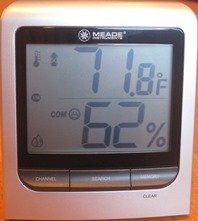Find a Mold Specialist Now
Click or Call, Toll-Free 24/7
Relative Humidity Sensor
A relative humidity sensor, technically known as a hygrometer, measures the amount of water vapor in the air, otherwise known as humidity. A temperature humidity sensor, including both a thermometer and a hygrometer, measures the air temperature as well as humidity. Hygrometers measure relative humidity, which compares the amount of water vapor in the air to the most water vapor that could possibly be in the air, which is determined by the temperature.
If that all sounds confusing, don’t worry. You don’t have to do the math yourself. A relative humidity sensor analyzes the data and expresses the relative humidity as a percentage. For example, most people feel most comfortable when the relative humidity in their home is below 50 percent.
Do You Need a Relative Humidity Sensor?
Not everyone has a relative humidity sensor in their homes. Some people just aren’t concerned about the humidity and others feel the humidity in their homes is at a comfortable level. Other people, however, want to manage the humidity in their homes in order to breathe more comfortably, prevent the growth of toxic mold or eliminate a musty odor. Controlling the humidity in your home can even prevent damage to wooden furnishings, painted surfaces and musical instruments. A temperature humidity sensor will give you the information you need to control the indoor climate at your home.
Controlling Your Indoor Climate
Most people prefer the indoor temperature to be around 70 degrees Fahrenheit. Some like it a bit warmer and some like it a little cooler. Some people save on energy costs by keeping the house cooler in winter and letting it get warmer in summer.
During warm weather, the humidity in a home usually rises because warm air can hold more water vapor than cool air. If the relative humidity in the home is greater than 50 percent, people usually feel uncomfortable. Some rooms may develop a musty odor and mold may begin to grow in the basement and/or bathrooms.
A temperature humidity sensor lets you monitor both the temperature and humidity in your home so you can then adjust both the temperature and humidity as desired. Use the thermostat in your home to adjust the temperature. To control the humidity in your home, you can purchase a dehumidifier. A dehumidifier pulls moisture out of the air so that the air is less humid. Many dehumidifiers allow you to select the amount of humidity you prefer and then automatically turn on and off as needed to keep the humidity at the desired level.
If you monitor the humidity in your home in several different areas, you can see if you only have a problem with high humidity in one area, such as the basement, or if it’s a problem throughout your house. You can purchase a portable dehumidifier to reduce the humidity in one area or a whole house dehumidifier that is installed with your home’s heating and cooling system to control humidity throughout the house.
Choosing the Best Humidity Sensor for Your Home
Look for a temperature humidity sensor that has multiple sensors so you can monitor the temperature and relative humidity in several areas of your home. A temperature humidity sensor that stores highs and lows in memory will make it easy to track the temperature and humidity in your home over time. Of course, you need a humidity sensor that is accurate as well as affordable.
We’ve compared a number of relative humidity sensors and found one made by Ambient Weather that we highly recommend. It’s highly accurate but also affordable. Just follow this link to Amazon to learn more about our Top Rated Humidity Sensor.
Return From Relative Humidity Sensor To Our Best Hygrometer Page
Black Mold Health Symptoms Home Page





